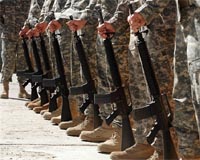| . |  |
. |
Baghdad (UPI) Jun 30, 2009 If Iraq's new-age armed forces prove to be incapable of maintaining security as the U.S. military withdrawal gets under way, it won't be because they lack weapons. On Feb. 14 the U.S. military announced it would be supplying Baghdad's forces with 140 M1A2 Abrams main battle tanks, F-16 Fighting Eagles combat jets and a plethora of high-tech weapons systems worth around $5 billion. That's one of the biggest rearmament programs ever in the Middle East, whose collective and constant requirement for weapons keeps the arms industries of the United States, Russia, Britain and France in business. On May 13 the U.S. Department of Defense awarded a $60.3 million contract to Bell Helicopter Textron for 24 Bell 407 gunships armed with Hellfire missiles and 2.75-inch rockets for the nascent Iraqi air force. There was an option for another 26 in various configurations that would raise the contract value to some $300 million. Two days later the Iraqi navy took delivery of the first of four Italian Saettia MK4 patrol craft built by the Fincantieri shipyard of Le Spezia. The 160-foot, 390-ton Fateh (Victory) will become the flagship of the new navy. The other three craft will be delivered at three-monthly intervals with a couple of dozen smaller patrol boats for the expanded 6,000-man navy. All told, U.S. military aid to Iraq -- mostly through the Foreign Military Sales program, which requires congressional approval -- will total around $8.7 billion over the next few years. However, the rearmament of Iraq could be threatened by the slump in oil prices that began in late 2008 -- from almost $150 a barrel to around $40 and currently running at $60. Baghdad, which relies on oil exports for 90 percent of its revenue, has been badly hit. The 2009 budget was slashed from $79 billion to $58.6 billion and may be cut further. So some weapons programs may have to be delayed until the crisis is over. And with the bulk of U.S. forces scheduled to be out of Iraq by the end of 2011, U.S. and Iraqi commanders are having to make some tough choices on prioritizing what is needed to give the Iraqis the firepower to maintain security on their own. U.S. President Barack Obama is concentrating military capabilities on the Afghanistan-Pakistan theater of operations, which has become the main battleground in the war against militant Islam, so Washington will not be able to finance the Iraqis' budget shortfall. The Iraqis are cutting unbelievably bloated payrolls at the key ministries concerned with security -- Defense and Interior -- but these may not be sufficient to give the armed forces what they need to contain external threats by 2012, which had been the target date. Just keeping the equipment they have, or will shortly get, in working condition will consume hundreds of millions of dollars. But corruption, endemic throughout the Iraqi government, is often as much an enemy as the insurgents and jihadists who plague the government of Prime Minister Nouri al-Maliki. The Iraqi army has a strength on paper of 262,000 -- although since soldiers are paid in cash, their commanders often inflate the size of their units and pocket the difference. Some embezzle up to $70,000 a month this way. No one really knows the true strength of the army. Billions of dollars in funds have disappeared from the Defense and Interior ministries in the last five years, seriously impeding the purchase of arms and equipment. Training has suffered too. As of mid-May about one-quarter of the Iraqi army failed to meet its own minimum qualifications for soldiers. "A small number are overage, a little bigger number of them would be medically disqualified, and then somewhere -- around 15 percent -- are illiterate," said Brig. Gen. Steven Salazar, a U.S. officer who is deputy commander of the Multinational Security Transition Command-Iraq. Poor control over the flow of U.S. and other weapons into Iraq for the new armed forces has also meant vast numbers of arms cannot be accounted for. At the heart of an ever-widening investigation by a posse of U.S. agencies is a mushrooming scandal in Iraq that has seriously eroded U.S. credibility in the Middle East -- the disappearance in 2004-05 of some 190,000 U.S.-supplied weapons intended for Iraqi security forces. There is evidence that some of the missing 110,000 AK-47 assault rifles and 80,000 pistols ended up in the hands of anti-U.S. insurgents and sectarian death squads. Share This Article With Planet Earth
Related Links Iraq: The first technology war of the 21st century
 US pullback in Iraq 'important milestone': Obama
US pullback in Iraq 'important milestone': ObamaWashington (AFP) June 30, 2009 President Barack Obama on Tuesday hailed the withdrawal of US troops from Iraqi towns and cities as an "important milestone," but warned of difficult days of bloodshed and violence to come. A careful White House also declined to declare victory, six years after the US invasion under ex-president George W. Bush spawned an insurgency that killed more than 4,300 US troops and tens of thousands ... read more |
|
| The content herein, unless otherwise known to be public domain, are Copyright 1995-2009 - SpaceDaily. AFP and UPI Wire Stories are copyright Agence France-Presse and United Press International. ESA Portal Reports are copyright European Space Agency. All NASA sourced material is public domain. Additional copyrights may apply in whole or part to other bona fide parties. Advertising does not imply endorsement,agreement or approval of any opinions, statements or information provided by SpaceDaily on any Web page published or hosted by SpaceDaily. Privacy Statement |